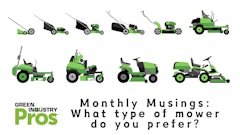
The abnormally high amount of rain Georgia has received this year has caused some headaches for commercial lawn maintenance contractors like Greg Parker, president of Parker Landscape Management (PLM) in Gray, GA. Scheduling has been a lot harder than usual. And the extra cleanup time needed on seemingly each and every property is pinching profits.
"Our weekly properties haven't been too bad, but the biweekly sites have required a lot more work," Parker relates. "We're spending more time on each job, so our man-hours are definitely running over." Nonetheless, PLM is having a record-setting year. "Although the rain has been difficult to manage, sales are up 38% and profit is at 12% so far this year, and 2013 will be the best year PLM has ever had," Parker adds.
Parker simply tries to control what he can. The equipment he puts on jobs is a great example. Some recent choices have proven to be smart ones this season as crews have been beaten, battered and pushed to the brink.
Bigger mower decks
Parker has used Exmark riding mowers for years. He doesn't use push mowers any longer. "Our business base has always been residential, but we're trying to grow our commercial more," Parker says. "So in the past we've always used 48- and 52-inch decks. For this season we bought a new zero-turn with a 60-inch deck for our larger commercial accounts. The extra cut width and horsepower have really paid off. Then we phased out our 48-inch mower and now use our 52, which has helped our production rates on the residential side."
Additionally, Parker sees no need for a more compact zero-turn rider—as might be necessary in certain residential settings where you have to get through a narrow gate to access a back yard. "If I can't fit my 52-inch riding mower through a gate, we just don't take that account," Parker explains.
The new 60-inch mower has a Kohler EFI engine. "I haven't been able to do a comprehensive analysis yet, but it does seem like we're getting a few more hours out of a tank of gas," Parker says. Kohler field data suggests that you can reduce fuel consumption by 25%, generally, when switching to a comparably sized EFI (electronic fuel injection) engine.
Powerful backpack blowers
"We run nothing but Stihl BR 600 backpack blowers," Parker says. "Some contractors in our area have been cutting back, but I find it beneficial to have a bigger, stronger blower." The BR 600 produces a 201-mph air velocity and 712-cfm air volume (with tube). "If all of your properties are weekly, you might not need as much power. But in my case, since we have a lot of biweekly accounts, we need more power. We also have a one-time major cleanup that requires a bigger blower, along with our fall leaf cleanups. So it makes sense for us to go with really powerful backpack blowers," Parker adds.
Lightweight trimmers
When it comes to string trimmers, Parker feels like he's found a hidden gem. "We use Stihl 100 models," he points out. "A lot of guys use either the 90 or the 110. But I like the 100 because it's a pound or two lighter, yet still has a stronger engine (31.4cc). That slight weight difference is huge when your guys are running trimmers eight hours a day. One drawback is that you can't swap out the head and put a steel blade on it. But my crews are just cutting grass, so we don't even want a steel blade. Weight is the main thing."
Saving time refueling
All PLM crews operate out of box trucks, one of which is a Super Lawn Truck. Among the SLT's unique features is its on-board fueling system. "This has been a huge benefit for us," Parker tells. "Before this, we were using 5-gallon cans. You'd end up spilling more than ended up in the trimmer. We also had to fill the cans up a couple times a day. Our Super Lawn Truck has a 14-gallon mix tank and a 40-gallon tank for straight gas. A crew can go almost two days before the tanks have to be re-filled."






























